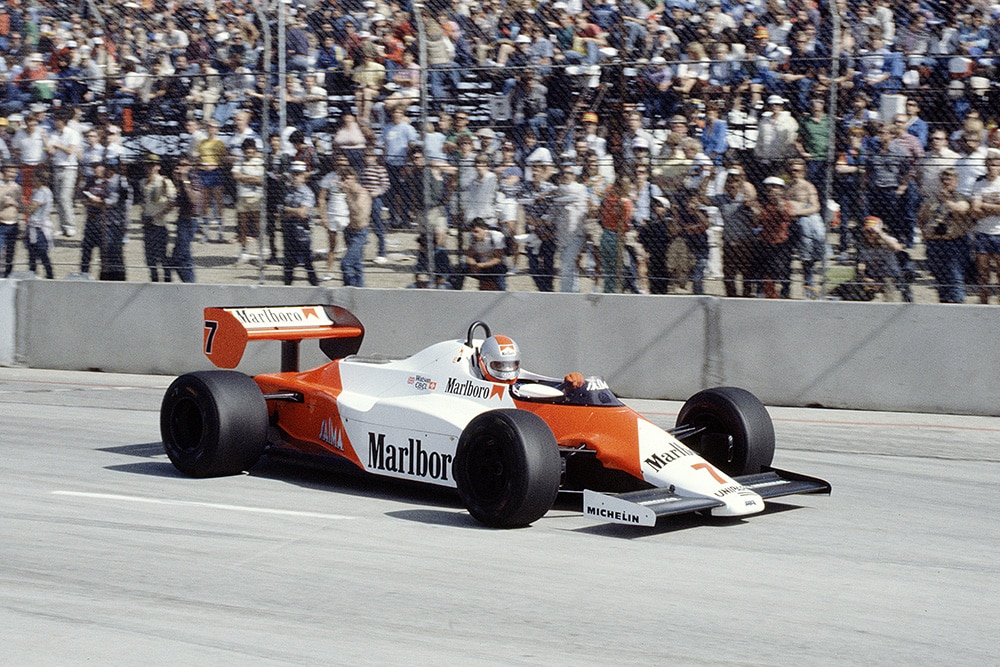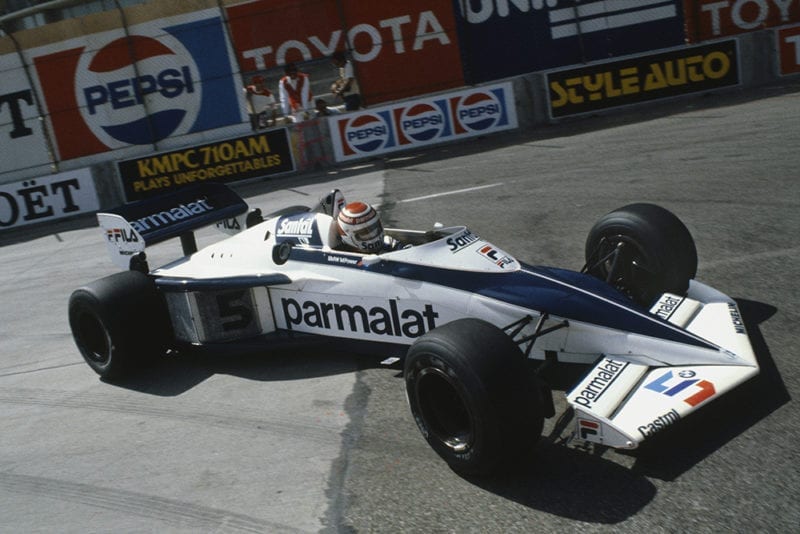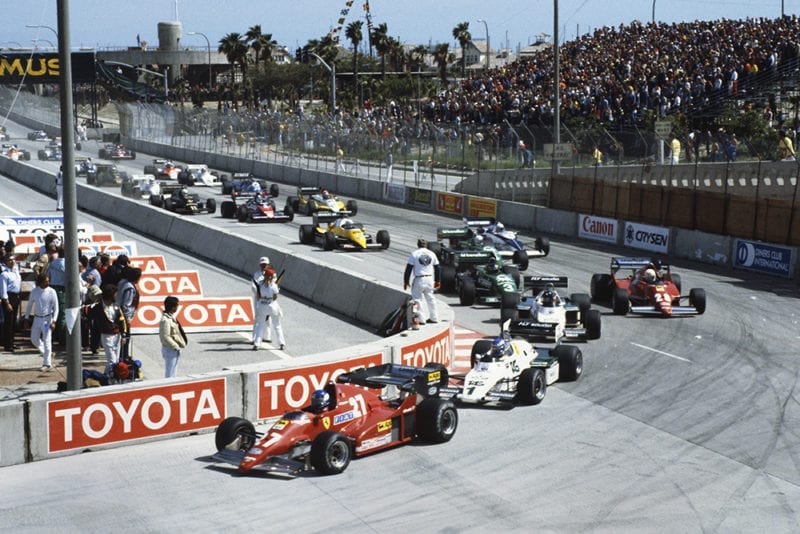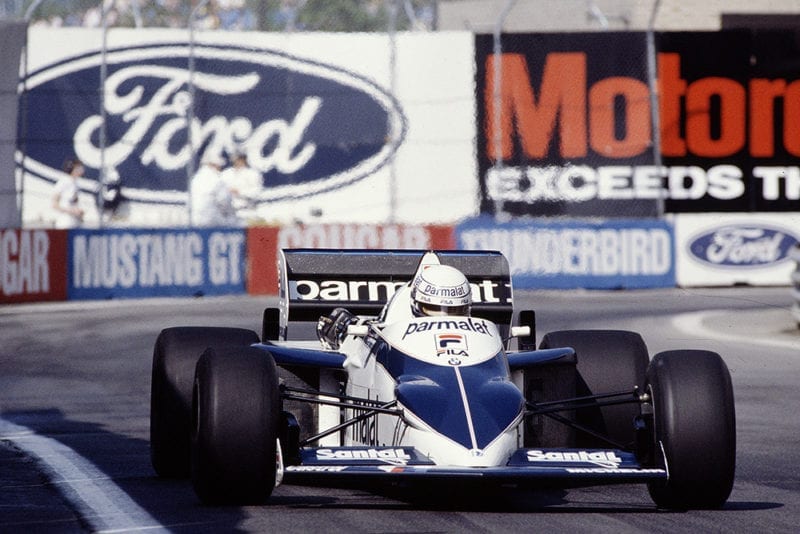1983 United States Grand Prix West race report

McLaren's John Watson came through from 22nd to win
Motorsport Images
Survival of the fittest
Long Beach, March 27th
At the time of its running it was suspected, but not confirmed, that it was to be the last Formula One race through the streets of Downtown Long Beach. The town itself actually finishes on the dual carriageway of Ocean Boulevard and in previous years one side of this road has been used as the top straight of the circuit and the other side of the dual carriageway, or Dubbel Pad as such roads are called in South Africa, formed the pit lane with temporary pits out in the open air. The circuit dived off the plateau of Downtown Long Beach to the harbour level below, twisted and turned through artificial corners laid out with concrete blocks and joined the concrete dual carriageway of Shoreline Drive. After running up one side to a hairpin it plunged down the other side, originally through a flat-out right-hand bend, but in recent years it went through a large chicane before taking the flat-out bend, thus reducing the maximum speed by about 10-15 m.p.h., down the following straight.
At the end the circuit used to do a right-hand hairpin to wiggle back to the foot of the edge of Downtown. Now it turns sharp right instead of a hairpin right, through a more interesting series of corners before climbing uphill onto Ocean Boulevard, or to be more exact, it did last year. This year the Ocean Boulevard section has been eliminated so that the whole circuit is now on the lower level and instead of the lap ending with a short rush uphill to the left it now turns right and left through a large closed-in car park, through a tight ess-bend and onto Seaside Way, running parallel to, but below the old pit straight. The pits themselves have been relocated on the dual carriageway of Shoreline Drive, where the start line is, making a much tidier layout altogether.
The inner lane of the dual carriageway is now the pit lane, the entrance being from the aforementioned chicane and the exit being at the far end of Shoreline Drive where the circuit turns sharp right. This exit was controlled by a marshal with a red light so there wasn’t much enthusiasm for indulging in refuelling pit stops during the race, as a bunch of cars approaching down the main straight could hold you at the red light for a disastrous length of time, to say nothing of having to rejoin the race behind a bunch of slower cars.

Nelson Piquet found himself down in 20th at the start
Motorsport Images
All these circuit modifications were to appease the townsfolk who objected to one of the main Boulevards being closed and to fit in with a big building programme taking place on the large flat harbour area, and they didn’t detract from the Long Beach atmosphere at all. It was the certain knowledge that the Long Beach Grand Prix Association could no longer afford the astronomical transport costs of carrying the Formula One circus from Europe to California, that was making this their last Formula One race.
In actual fact the teams were all transported from Rio de Janeiro to California, still a costly operation and I didn’t hear any of the teams offering to pay their own travel costs out of the multi-million pound sponsorship contracts.
Qualifying
The result of “end-of-the road” feeling was that testing on Friday morning lacked any real fire or purpose and what there was dissipated by the discovery that there was a large bump on the top straight that threw the cars into the air at 150 m.p.h. There were in fact two bumps caused by the meeting of two road cambers at right angles to each other, one on the circuit and the other on the road coming downhill from Ocean Boulevard to the harbour level. If you lifted off for the first bump you landed on the second one with your rear wheels if you were lucky, whereas if you kept hard on the throttle over the first bump you cleared the second one but landed heavily just before the braking area for the sharp-right hand turn at the end of the straight. Neither method of negotiating the top straight was popular, though some drivers were not worried while others feared for the strength of their suspension systems and could not see them lasting 75 laps.
Overnight on Friday the organisers filled in the depression between the two bumps with a quick-drying concrete, making a single bump of the road junction and it solved the problem. The Toleman team packed up and went back to their workshop for modifications when Warwick’s car broke a rear suspension member. They pulled Giacomelli in before a disaster happened. With the exception of Renault and Arrows, all the teams were running the same cars and drivers as they had used in Brazil two weeks before. Renault brought over their new prototype RE40 for Alain Prost as the modified RE30 model was outclassed in Brazil. The new car was given the chassis number of 00 as it was a rather unsanitary test car, with the new carbon-fibre composite monocoque chassis, pull-rod front suspension in place of rocker arms and exhaust pipes pointing upwards just ahead of the rear wheels.

Renault’s Eddie Cheever qualified 15th
Motorsport Images
In Europe the sign 00 on a door denotes the lavatory. After running perfectly on test at the Willow Springs track earlier in the week, the car developed a high-speed misfire that persisted throughout the weekend. The engine was changed, the injection system was changed, all the electrical gear was changed but still the misfire was there and a less stoic driver than Alain Prost would have given up in despair. Eddie Cheever, in an RE30C, fluctuated throughout the weekend between bouts of going quite fast and contact with the unforgiving concrete walls and breaking his gearbox. His best accident caused him to abandon his own car RE30C/II, and use Prost’s spare car RE30C/12 for the race, but another broken gearbox caused his retirement. Altogether another disastrous weekend for Renault-Sport.
The Arrows team replaced “Chico” Serra in their second car with Alan Jones, the Australian making his come-back to Formula One as described elsewhere. Key notes of practice and qualifying were power and tyres and Ferrari had both with their turbo-charged V6 and Goodyear tyres. On Friday Arnoux was so much faster than everyone else it was ridiculous, and on Saturday Tambay calmly took pole position on his first allowed set of Goodyear qualifying tyres and then sat in the car with his second set on, waiting for someone to beat his time. No-one did so he did not bother to go out again.
Arnoux’s Friday time gave him second overall so it was an all-Ferrari front row. Rosberg and Laffite filled the second row of the grid, also on Goodyear tyres, though their Williams Cosworth V8s were not in the same league as the Ferraris. In row three were de Angelis with the Renault-powered 93T and Warwick with the Hart-powered Toleman, both on Pirelli qualifying tyres. Most of the Michelin-shod cars were right out of the picture, Piquet in his Brabham-BMW being a lowly 20th and Watson and Lauda in the Michelin-shod McLarens being in unbelievable 22nd and 23rd places. On Saturday evening after practice and qualifying was all over it was felt that anyone running on Michelin tyres need hardly bother to start the race. It was a foregone Goodyear walk-over, with Pirelli playing the wild card, but no-one knew whether their tyres for the race would match up to their qualifying tyres.
Race

Tambay leads at the first corner
Motorsport Images
By Sunday evening Goodyear’s Leo Mehl was saying “What the hell happened out there?” Those Goodyear drivers who didn’t wear their tyres out ran into each other and the two Michelin-shod McLarens sailed by into a majestic 1-2, with Watson leading Lauda home comfortably. Watson had chosen a different type of Michelin to Lauda, and his gamble paid off for Lauda could not challenge him and had to let Watson run away to a resounding victory. In the opening stages the two McLarens were so far back you could forget about them and there was a good scrap going on at the front of the race with Tambay leading the dance in his Ferrari, closely followed by Rosberg (Williams), Laffite (Williams), Alboreto (Tyrrell), Arnoux (Ferrari) and Patrese (Brabham).
Arnoux had been struck by Rosberg at the start, which put his steering awry and when he could no longer maintain the pace of the leader he stopped for a tyre change. Jarier was having an on-day in the odd-looking Ligier JS21 and was up with the leading bunch, but after Rosberg punted Tambay out of the race Jarier punted Rosberg and himself out of the event. Laffite led for a long time followed by Patrese, but the Brabham driver had a big spin which let the two McLarens by and then Laffite’s tyres were worn out and the two McLarens went by into first and second places, which they held to the end.
With new tyres on his Ferrari Arnoux really got going and a muddle in the Williams’ pit lap-charting told Laffite that he was safely in third place, with Arnoux a lap behind when in fact the Ferrari was on the same lap. Near the end of the 75 laps Laffite actually moved over and let Arnoux go by, thinking he was merely joining the Williams on the same lap, whereas he was actually taking third place. There were two turbocharged V8 Alfa Romeos in the race, but you would hardly have noticed it unless you were an Alfa enthusiast, and then you would have seen Baldi’s car crunched up against a concrete wall, and de Cesaris’ car retired in the pits with a broken gearbox, which the Alfa team described as “electrical trouble”. Alboreto’s brief run near the front of the race ended with a stop for a change of tyres but his Tyrrell team-mate Sullivan ran through non-stop.

Riccardo Patrese managed 10th for Brabham
Motorsport Images
Various little incidents and skirmishes looked exciting on their own, but overall it was a rather boring affair and a dull note on which to end Formula One racing at Long Beach. Notes made on my own personal lap-chart during the race are self explanatory.
Lap 12. Ooh!!! Arnoux squeezed by Alboreto where there wasn’t room and got away with it.
Lap 15. Tambay is driving really nicely, pacing himself to the speed of his followers who are tending to fall over each other.
Lap 21. It’s all neat and tidy. Tambay, Rosberg, Laffite, Affioreto, Jarier, Patrese, Arnou.. The last-named must have had a “moment” somewhere.
Lap 25. It’s all falling apart. Tambay and Rosberg have pulled away, Laffite is in tyre trouble. Alboreto has gone into the pits, Cheever is in the pits, Prost is in the pits.
Lap 26. It’s all turned sour. Tambay gone, Rosberg gone and here is Jarier stopping at the end of the straight.
Lap 29. Laffite leading Patrese and then a long, long gap and (would you believe) Lauda. He could win this contest, and Wattie is close behind him.
Lap 30. It’s become rather boring.
Lap 33. Watson has just outbraked Lauda at the end of the straight and is now third. All that practice was a total waste of time.
Lap 40. Patrese would like to have a go at Laffite for the lead but he’s just not close enough.
Lap 43. Ooops!!! Patrese has spun, and the clever lad has kept the BMW turbo on the boil, but Watson and Lauda have gone by.
Lap 45. The two McLarens have sailed by Laffite’s Williams. This is ridiculous.
Lap 50. On and on, Lauda can’t keep up with Wattie! Tyres?
Lap 60. On and on, very boring now.
Lap 65. Wonder why Williams pit are giving Laffite +198 seconds sign? That’s more than two laps ahead of Arnoux. That can’t be right.
Lap 70. Everyone else seems to think Arnoux is third. He’s certainly motoring some on his third new set of Goodyears.
Lap 75. The end.

Winner John Watson celebrates with Niki Lauda (left) and Rene Arnoux (right)
Motorsport Images
Watson, Lauda and Arnoux up on the winner’s podium which seems to be hidden away in the pits where no-one can see it.
Funny old race, but there’s Watson up on top when it really counts. As the Derbyshire racing motorcyclist John Cooper used to say “It’s first under the black and white linen that counts.” Long Beach Grand Prix of the United States West, we shall miss you. D.S.J.
